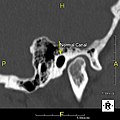| Surfer's ear | |
|---|---|
 | |
| Exostoses in the ear canal, as seen through otoscopy | |
| Specialty | ENT surgery |
Surfer's ear is the common name for an exostosis or abnormal bone growth within the ear canal. They are otherwise benign hyperplasias (growths) of the tympanic bone thought to be caused by frequent cold-water exposure. [1] Cases are often asymptomatic. [1] Surfer's ear is not the same as swimmer's ear, although infection can result as a side effect.
Contents
- Signs and symptoms
- Causes
- Prevalence
- Prevention
- Treatment
- Archeology
- See also
- References
- External links
Irritation from cold wind and water exposure causes the bone surrounding the ear canal to develop lumps of new bony growth which constrict the ear canal. Where the ear canal is actually blocked by this condition, water and wax can become trapped and give rise to infection. The condition is so named due to its high prevalence among cold water surfers, although it can occur in any water temperature due to the evaporative cooling caused by wind and the presence of water in the ear canal.
Most avid surfers have at least some mild bone growths, causing little to no problems. [2] The condition is gradually progressive and can generally be prevented by shielding the ear from water by consistently using earplugs and wetsuit hoods. The condition is not limited to surfing and can occur in any activity with cold, wet, windy conditions such as windsurfing, kayaking, sailing, jet skiing, kitesurfing, and diving.



